When it comes to Italian cuisine, oregano is a popular herb known for its distinctive flavor profile that elevates pasta sauces, pizza, and various other dishes. However, there are times when you need a substitute for oregano to infuse your recipes with different, yet equally delightful, flavors. Let’s delve into the world of oregano alternatives, uncovering the best oregano substitutes that will keep your taste buds singing while adding a scrumptious bite to your culinary creations.
This post may contain affiliate links.
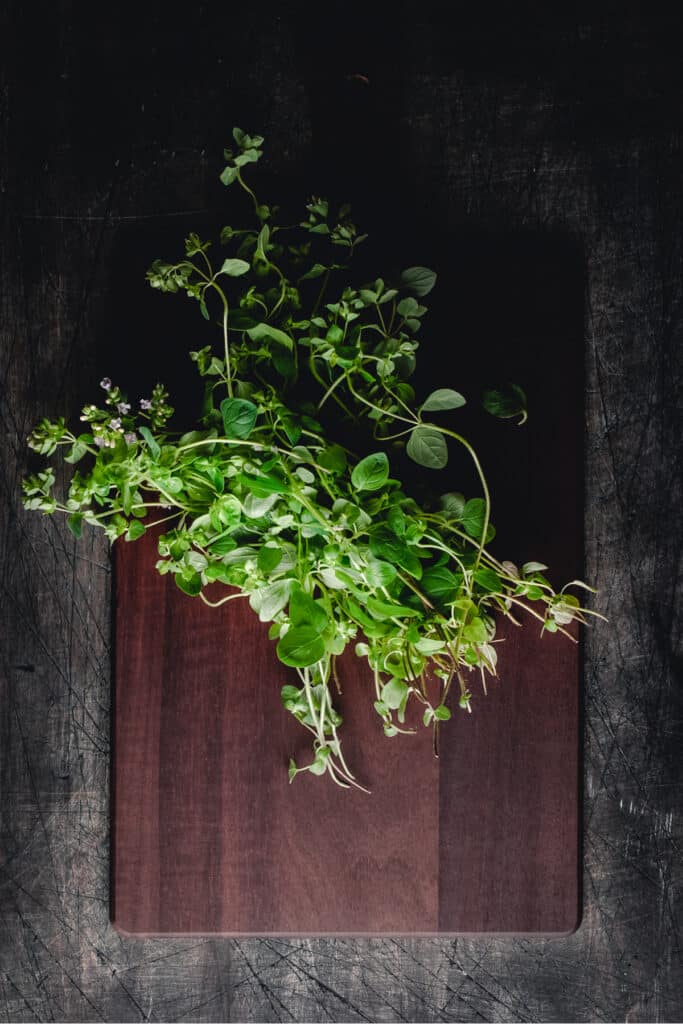
What You Need to Know About Oregano
First things first, for you to make an appropriate substitution for oregano in tonight’s dinner, let’s go over a few details that make oregano unique:
- Oregano is part of the Mint family! (Along with several other flavorful herbs.)
- Oregano is commonly used in both fresh and dried forms.
- The taste of oregano is bold, comforting, earthy, aromatic, and the perfect blend of sweet and bitter.
- It is a popular herb in Italian, Mexican, Greek, and Turkish cuisine.
- It’s no surprise these cuisines use the herb so readily, as oregano is grown in Mediterranean countries and some parts of Asia and North America.
- Oregano is also one of the most commonly found herbs in dishes cooked around the world!
Substituting Dried with Fresh Oregano
You can use dried oregano instead of fresh oregano in almost any recipe that calls for this herb!
Fresh herbs are always favorable for taste and adding texture to a dish, but dried oregano is easier to keep in the cupboard to have on hand at a moment’s notice. Some recipes also require one or the other. For example, a Greek salad with vegan feta, red onion, green peppers, and cucumber works best with dried oregano. However, garnishing is always best with fresh oregano.
Dried herbs are more potent than fresh herbs. When substituting oregano, use one-third of the quantity of dried oregano compared to fresh oregano (chopped).
A good rule of thumb is to use a 3:1 ratio. That is, three parts fresh oregano is roughly equivalent to one part dried oregano.
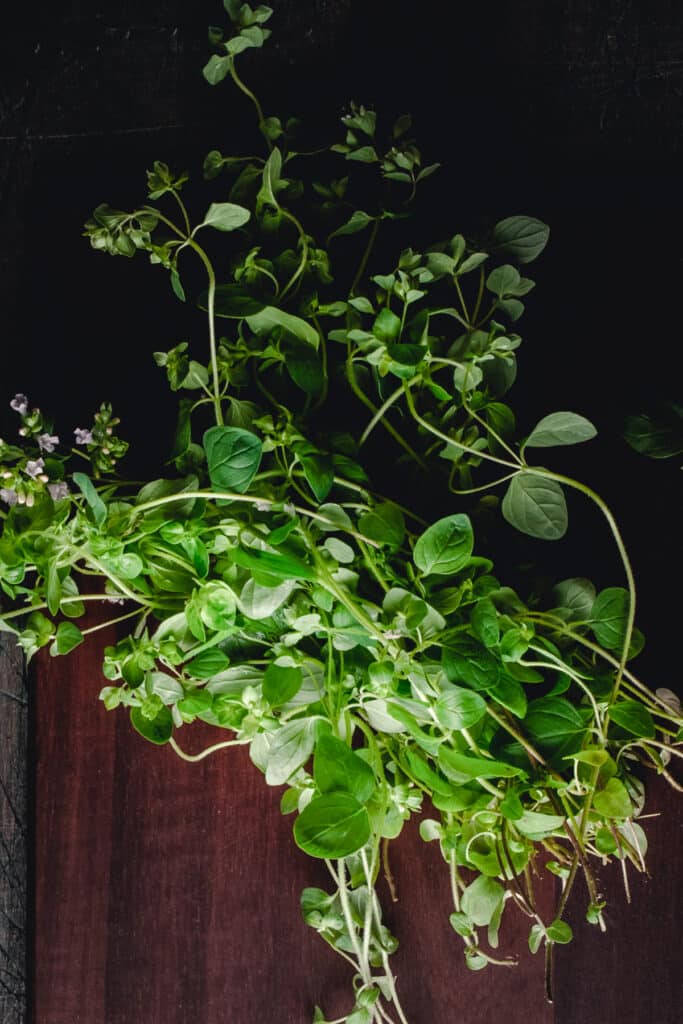
Hacks for Substituting Herbs
Here are my top hacks for finding an oregano seasoning substitute, if you find yourself in a pickle with no oregano for tonight’s recipe, or if you are looking to test out new herb combinations in your cooking to give a new lease on life to a family favorite dish, these are for you.
- My number one tip is to experiment. Add a scoop of the recipe you’re cooking into a separate bowl and add a little bit of the herb at a time. This way, you can check that the seasoning compliments your meal before adding it to the entire recipe.
- Another thing you can do is a smell test. Generally, you should be able to give an herb or spice that you are considering for a substitution a sniff and see if you think the flavor fits your recipe’s theme.
The List: 25 Best Substitutes for Oregano
Are you looking for substitutes for oregano? Of course, it goes without saying that no herb’s flavor profile is identical, so there is no “perfect” substitute for oregano in every recipe. However, there are ways you can enhance the flavor of your dish using other herbs and spices when you don’t have oregano to hand.
What is a good replacement for oregano leaf? Glad you asked! Here are the best herbs for substituting oregano and what you should know about each alternative.

1. Fresh Mexican Oregano
Mexican oregano would be the best substitute if you can find it! (The most common oregano variety found in American grocery stores is “Greek Oregano.”) Mexican oregano is obviously not the same as traditional oregano. However, it is a great replacement used in Mexican dishes and certain Italian recipes such as pasta sauce.
2. Dried Mexican Oregano
Dried Mexican oregano is a great option for a variety of Mexican and Tex-Mex dishes, including salsas, marinades, and chili recipes, to impart its distinctive earthy and citrusy flavor. Due to this flavorful herb being so closely related to Greek oregano, it is the best herb to use in place of oregano.
3. Dried Italian Seasoning
If you don’t already keep an Italian seasoning mix in your cupboard, you need to head over and pick one up because this dried herb seasoning is a great alternative when you are running low on the most common Italian herbs.
As oregano is a key component of this seasoning mix, you can usually substitute it with ease into most dishes as a dry oregano substitute.
4. Fresh Marjoram
Closely related to oregano, marjoram leaf offers a milder, sweeter flavor that works particularly well in Mediterranean and Italian dishes. (Another member of the mint family.)
5. Dried Marjoram
A wonderful option for a dry oregano substitute is dried marjoram, as it has the closest flavoring of all the commonly found herbs in most grocery stores.
6. Fresh Basil
With its slightly sweet and peppery taste, fresh basil leaf can provide a new twist to dishes usually seasoned with oregano.
7. Dried Basil
If you are cooking a southern European dish such as an Italian, Mediterranean, or Greek dish, dried basil is your best oregano alternative due to the herbs’ similar flavor and potency.
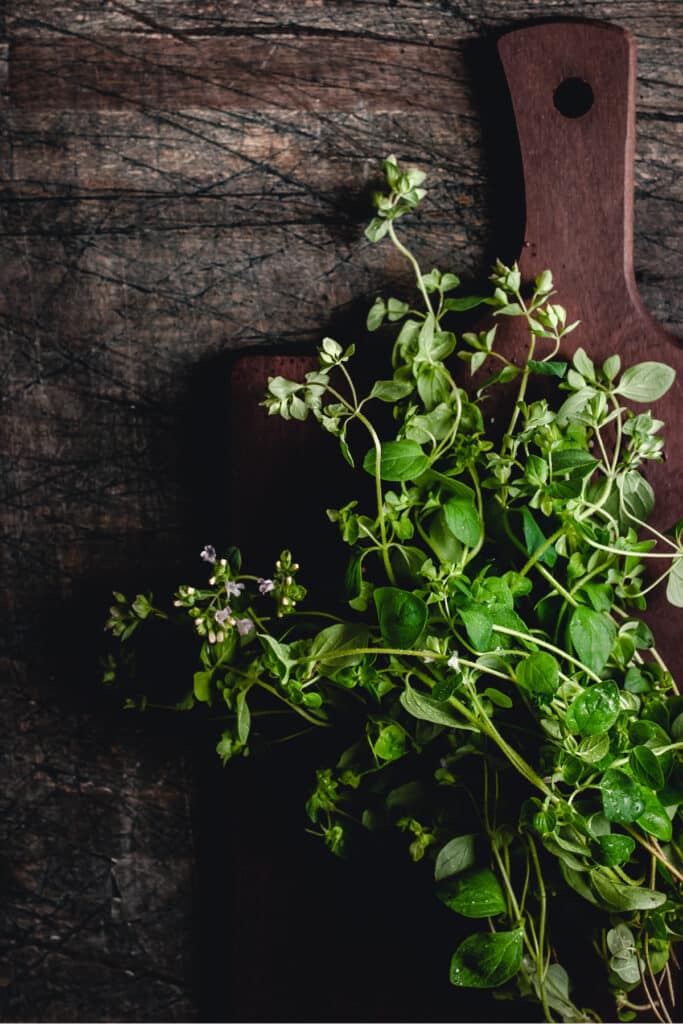
8. Fresh Thyme
Thyme leaf and oregano look similar when fresh, so this is an obvious choice for an oregano alternative. Together with a comparable appearance, these herbs complement each other well in most recipes.
9. Dried Thyme
Known for its delicate yet robust flavor, thyme is a versatile herb that pairs well with a variety of dishes, making it an excellent oregano alternative.
10. Fresh Rosemary
For a more pine-like flavor, consider using rosemary sparingly as a substitute in dishes where oregano is typically used. Rosemary can be used to flavor grilled vegetables, potatoes, and even bread, infusing them with its distinct fragrance. It’s a common ingredient in Mediterranean and Italian cuisine, adding depth to pasta sauces, marinades, and herb-infused oils.
11. Dried Rosemary
Dried rosemary serves as a compelling substitute for oregano, imparting its own unique aromatic qualities that complement a variety of dishes. Rosemary also pairs well with citrus flavors, making it a delightful addition to dishes like roasted lemon asparagus or citrus-infused desserts.
12. Fresh Mint
For a surprising twist, mint’s refreshing and slightly sweet taste can be used to replace oregano in certain dishes. Fresh mint is commonly used in dishes like salads, beverages, and desserts to add a refreshing and aromatic flavor.
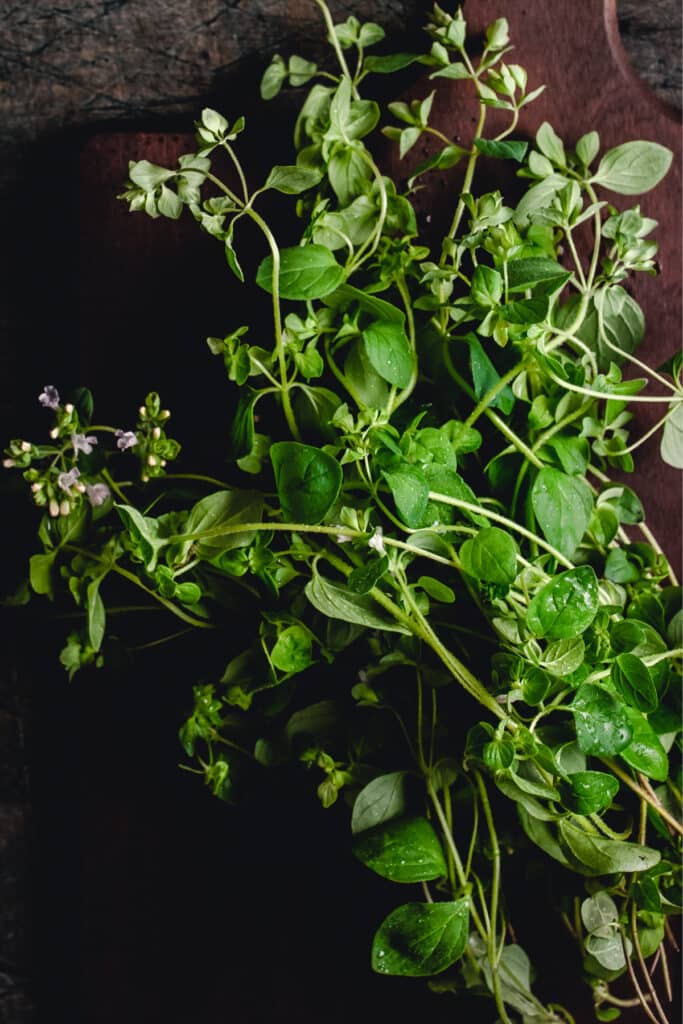
13. Dried Mint
Dried mint serves as a good substitute for oregano, offering a similar herbaceous quality that can complement a variety of dishes with its aromatic and slightly minty flavor.
14. Fresh Summer Savory
Summer savory is a versatile herb that finds its place in a wide range of dishes. Fresh summer savory can be a wonderful substitute for oregano, bringing its own unique blend of earthiness and subtle peppery notes to dishes.
15. Dried Summer Savory
Dried summer savory serves as an excellent oregano substitute. It’s often used to enhance the flavors of bean dishes, lentil soups, and stews, where its earthy and slightly peppery notes can complement the hearty ingredients.
16. Fresh Parsley
While milder, parsley‘s freshness can enhance dishes much like oregano does. It is a popular herb for heavy tomato recipes or Italian sauces.
17. Dried Parsley
Dried parsley has a more subtle flavor than oregano, but it is more potent than fresh parsley. Dried parsley is commonly used as a versatile herb to add a touch of mild, herbaceous flavor to a wide range of dishes such as soups, stews, pasta sauces, salads, marinades, and even as a garnish for a pop of color and subtle taste.
18. Fresh Dill
You probably know dill weed for being in yogurt dips and fancy garnishes. It looks a bit like thin grass and is incredibly delicate in appearance. Although it wouldn’t be my first choice for an oregano substitute, you can use it effectively in some North African and Middle East recipes.
19. Dried Dill
Dried dill is good for adding a burst of herbaceous and slightly tangy flavor to dishes like salads, soups, and dips.
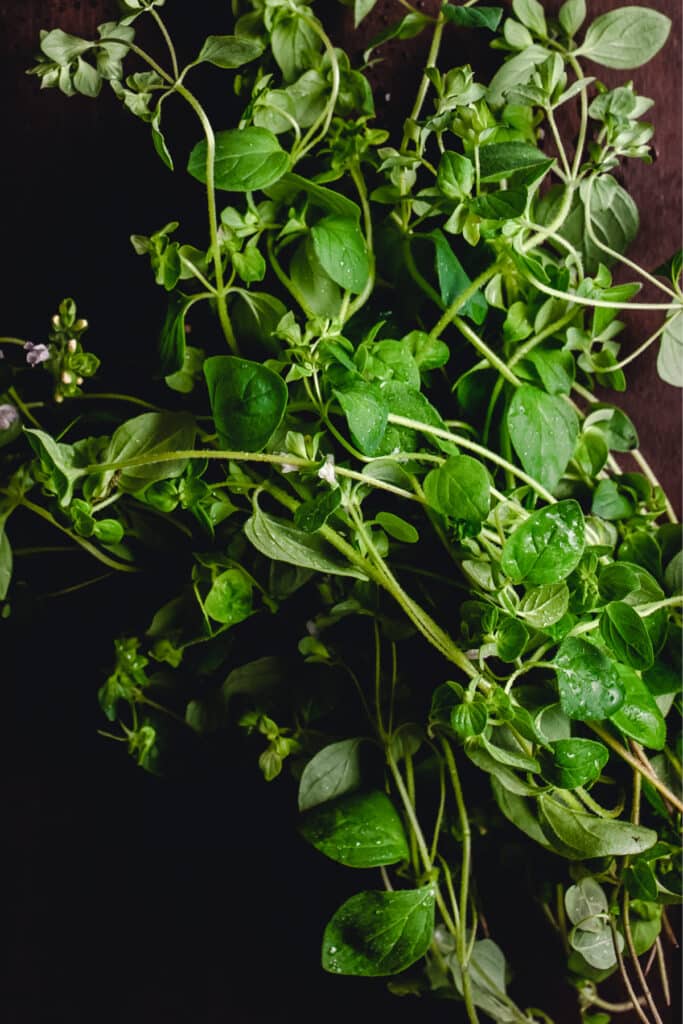
20. Fresh Tarragon
Tarragon has a unique and distinctive flavor profile characterized by its subtle anise-like taste. It offers a delicate blend of herbal notes with hints of licorice, citrus, and a touch of sweetness.
21. Dried Tarragon
Dried tarragon works well in tomato-based recipes as a replacement for oregano. Although this potent herb is unique, it works well with similar dishes to oregano, such as salad dressings.
22. Fennel Seeds
Fennel seed and fennel seed powder aren’t as versatile a substitute for oregano as some other herbs on this list.
Fennel seeds have a distinct taste that is often described as slightly sweet with a strong, anise-like flavor. They carry a prominent licorice-like note along with herbal and slightly earthy undertones. Fennel seeds can add a complex and aromatic dimension to dishes, making them a popular ingredient in both savory and sweet recipes.
23. Fennel Seed Powder
Fennel seed powder is created from grinding fennel seeds. It retains the same distinctive taste as whole fennel seeds. It offers a concentrated version of the herb’s flavor profile. Fennel seed powder is often used as a spice to add depth and complexity to a variety of dishes, ranging from savory recipes like curries and soups to baked goods and desserts where its unique flavor can shine through.
24. Fresh Sage
In smaller quantities, sage‘s aromatic and slightly bitter profile can be a surprising but effective alternative to oregano. This popular herb is very different from oregano, and you’ll be able to recognize a dish with sage leaves a mile away. It isn’t a like-for-like substitute but can add a delicious flavor to your holiday dishes.
25. Dried Sage
Dried sage has a strong and earthy flavor profile with warm, woody, minty, and slightly peppery undertones, contributing an aromatic and savory note to dishes. It is used to add its strong and earthy flavor to dishes like roasted meals, stuffing, soups, sauces, and various baked goods.
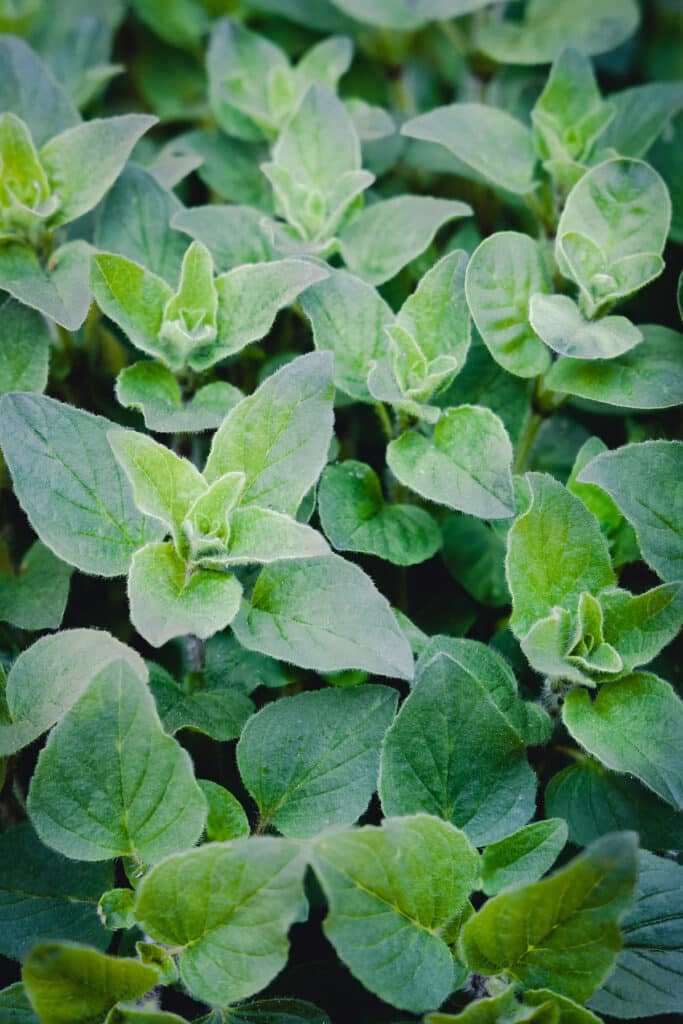
My Go-To Recipes with Oregano
FAQ
The best substitutes for oregano in chili are, hands down, thyme, sage, basil, and marjoram. Use just one or two of these in your recipe, do a quick taste test (yum!), and see if you feel it needs anything else.
Alternatively, use my vegan pumpkin chili recipe, which only requires cumin and chili powder as the dry herbs and spices and no fresh herbs. Winning!
When it comes to the best oregano for pizza, I recommend using dried oregano if you add the herbs before cooking. This is because fresh oregano can shrink during cooking and lose its flavor.
It also looks wilted and sad when it withers due to the heat. Feel free to add fresh oregano garnishing for a pop of green when serving to impress your guests!
Here’s a delicious vegan pizza recipe for when the cravings hit!
Sure! Using parsley as an oregano alternative is best with tomato-based saucy dishes. Both are powerful herbs, so you can use the same quantity of parsley for oregano when you make a substitution.
To get the most out of your fresh oregano, store it in a plastic bag in the fridge. The herbs should stay fresh and fragrant for three days. However, feel free to use them on day 4+ as long as they don’t appear too limp and lifeless.
My top tip is to wet a sheet of kitchen paper, ring it out, so it’s damp, and then place the sheet flat in the bag with the herbs. Then leave a tiny gap for air. These hacks should give your fresh herbs the best chance of survival in your fridge so you can use fresh herbs for days!
The key to making your herbs last longer and avoiding waste (frantically searching for articles like this about substitutes and any emergency trips to the grocery store, which is always a pain!), keep your herbs away from oxygen and moisture when possible.
Therefore, you need to ensure your herbs are completely dry before storing them in an airtight container in a cool, dark location away from direct sunlight. It is also best to avoid keeping dried herbs near the range, where they may become warm and moist from the stove.
Although dried spices tend to last longer than dried herbs, you can keep your dried herbs for a number of years before they start to go bad. And even then, the herbs will just lack flavor, but they won’t necessarily be dangerous.
Typically dried herbs can last 1-3 years. However, this will depend on your storage methods, how hot your kitchen is, and what kind of herbs you use. Although, if you’re anything like me and you love cooking, your herbs may never even see their first birthday!
As mentioned, a good rule of thumb, you should use one-third of the amount of dried herbs compared to their fresh counterparts. This rule means that for every tablespoon of fresh oregano, you only need about one teaspoon of dried oregano.
This is because dried herbs are stronger and more potent than fresh herbs, so you need to use less to avoid the more powerful flavor overpowering your dish. And although I love oregano as much as the next person, I’m not sure I want half my spoonful to be dried herbs, haha.
Video of Fresh & Dried Oregano
Final Words
The culinary world is filled with a plethora of alternatives that can seamlessly step in for oregano, providing a delightful twist to your favorite dishes. Each substitute brings its own unique flavor profile to the table. Whether you’re crafting Mediterranean masterpieces, experimenting with Italian classics, or venturing into new culinary territories, the 25 best substitutes for oregano listed in this article offer a spectrum of tastes that can elevate your dishes to new heights.
Remember, the key to successful substitutions lies in understanding the flavor profile of each alternative and how it complements the overall composition of your recipe. So, don’t hesitate to explore, experiment, and embark on a flavorful journey by embracing these oregano alternatives in your kitchen. Your taste buds are in for a delightful adventure!
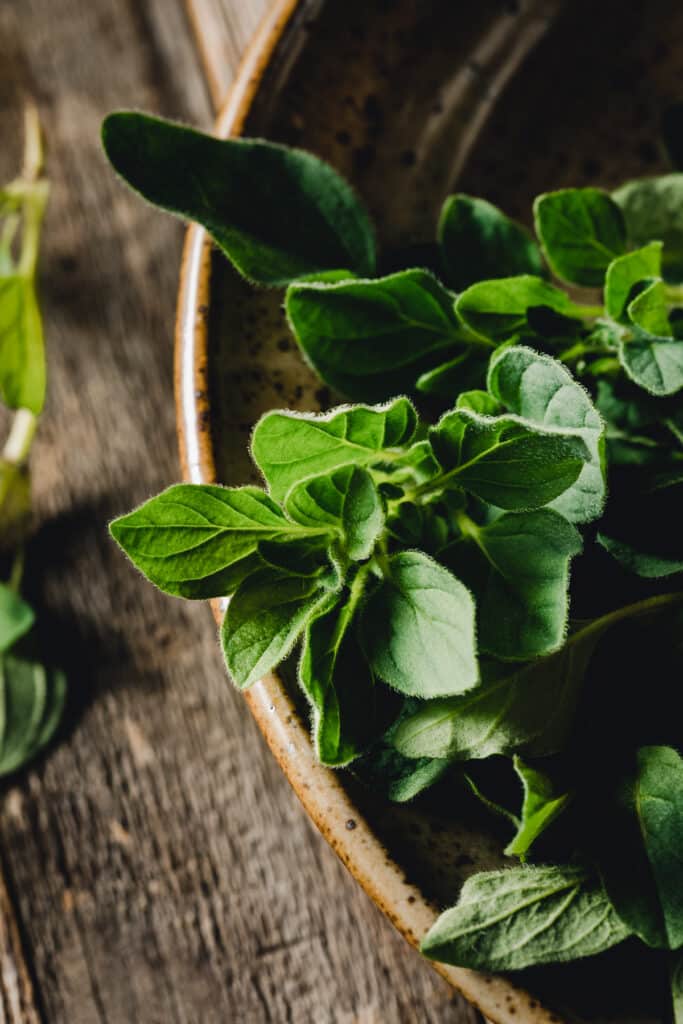
Looking For A Different Substitution?
Here are some more helpful resources for ingredient substitutions when you don’t have the right item on hand.
- Best Substitutes For Basil
- 21 Best Substitutes For Turmeric
- 20 Best Substitutes Leek Substitutes
- 17 Best Vegetable Bouillon Substitutes
This post may contain affiliate links, which means I’ll receive a commission if you purchase through those links at no extra cost to you. Please read our full disclosure for more information. Thank you for supporting Raepublic.

Very detailed and informative.
Thanks, Jon. I’m glad you found it useful!
This blog post is great! It has so much information and answers so many of my questions. Thank you!
So glad you like this post, Amber. Do you have a favorite substitute for oregano?